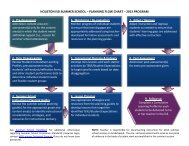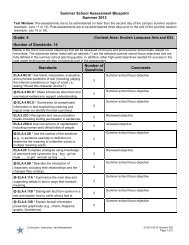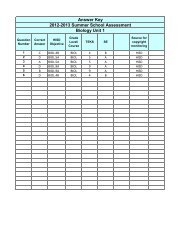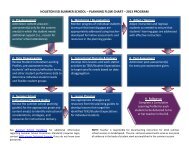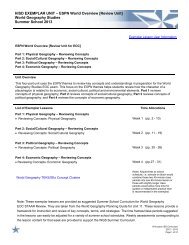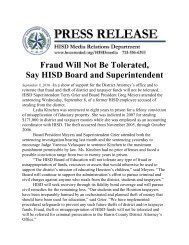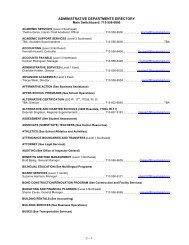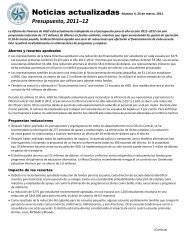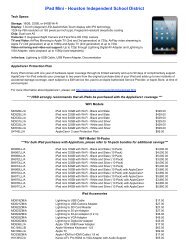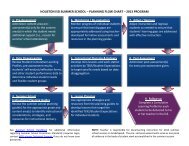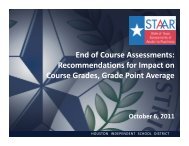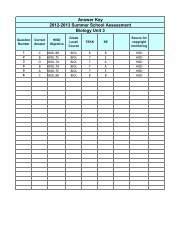SSK Unit 4.2 Planning Guide
SSK Unit 4.2 Planning Guide
SSK Unit 4.2 Planning Guide
- No tags were found...
You also want an ePaper? Increase the reach of your titles
YUMPU automatically turns print PDFs into web optimized ePapers that Google loves.
<strong>Unit</strong> 3: Expository Texts<strong>Unit</strong> OverviewHISD PLANNING GUIDEEnglish Language Arts Grade 7SUMMER SCHOOL<strong>Planning</strong> <strong>Guide</strong> User InformationTime Allocations<strong>Unit</strong> 31weekExpository Texts– This unit reviews the genre of informational nonfiction with an emphasis on expository texts.Students analyze author’s style and purpose through the study of organizational patterns, text features, and sentenceconstruction as well as draft, revise, edit, and publish an expository essay.Texas Essential Knowledge and Skills/Student Expectations (TEKS/SEs) (district clarifications/elaborations in italics)VocabularyR ELA.7.2A Determine the meaning of grade-level academic English words derived from Latin, Greek, or otherlinguistic roots and affixes.ReadingELA.7.Fig19A Establish purposes for reading selected texts based upon own or others’ desired outcome to enhancecomprehension.ELA.7.Fig19C Reflect on understanding to monitor comprehension (e.g., summarizing and synthesizing; makingtextual, personal, and world connections; visualizing).R ELA.7.Fig19D Make complex inferences about text and use textual evidence to support understanding.R ELA.7.Fig19F Make connections between and across texts, including media (e.g., film, play, music, print media),and provide textual evidence.R ELA.7.10A Evaluate a summary of the original text for accuracy of the main ideas, supporting details, and overallmeaning.R ELA.7.10C Use different organizational patterns (e.g., proposition-and-support, problem-and-solution, cause-effect,compare-contrast, inductive, deductive, chronological order) as guides for summarizing and forming an overview ofdifferent kinds of expository text.R ELA.7.10D Synthesize and make logical connections between ideas within a text and across two or three textsrepresenting similar or different genres, and support those findings with textual evidence.S ELA.7.12B Explain the function of the graphical components of a text.WritingR ELA.7.14B Develop drafts by choosing an appropriate organizational strategy (e.g., sequence of events, causeeffect,compare-contrast) and building on ideas to create a focused, organized, and coherent piece of writing.R ELA.7.17A.i Write a multi-paragraph essay to convey information about a topic that presents effective introductionsand concluding paragraphs.R ELA.7.17A.ii Write a multi-paragraph essay to convey information about a topic that contains a clearly statedpurpose or controlling idea.R ELA.7.17A.iii Write a multi-paragraph essay to convey information about a topic that is logically organized withappropriate facts and details and includes no extraneous information or inconsistencies.R ELA.7.17A.iv Write a multi-paragraph essay to convey information about a topic that accurately synthesizes ideasfrom several sources.R ELA.7.17A.v Write multi-paragraph essays to convey information about a topic that uses a variety of sentencestructures, rhetorical devices, and transitions to link paragraphs.R ELA.7.14C Revise drafts to ensure precise word choice and vivid images; consistent point of view; use of simple,compound, and complex sentences; internal and external coherence; and the use of effective transitions after rethinking - English Language Proficiency Standards (ELPS) - Literacy Leads the Way Best Practices - Aligned to Upcoming State Readiness Standard- State Process Standard R - State Readiness Standard S - State Supporting Standard© Houston ISD Curriculum2012 – 2013Page 1 of 12




